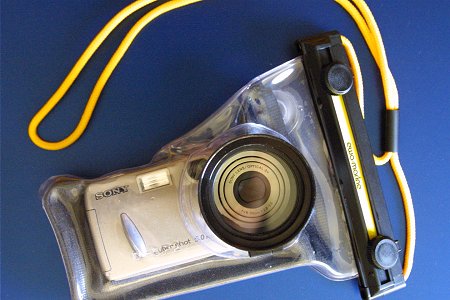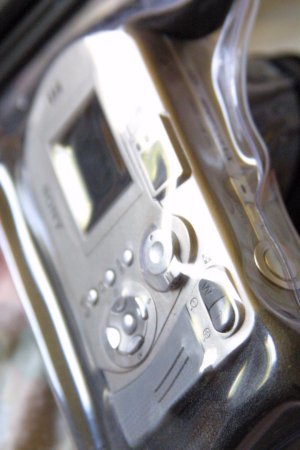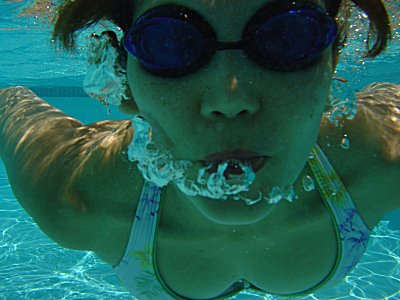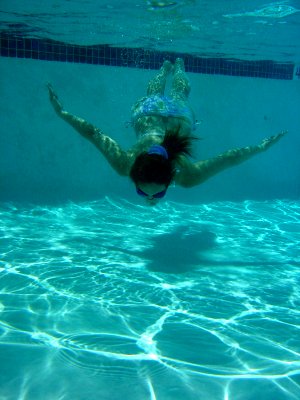ewa-marine D-CP2 Underwater Housing
Anticipating the yearly hot summer days of Los Angeles, I looked into purchasing an underwater housing for my digital camera back in spring. I wanted to shoot some underwater pictures in the pool, in parallel with the swimming events of the 2004 summer Olympic Games that is occurring in Athens. An underwater housing for my Sony Cyber-shot DSC-P92 digital camera would be perfect, since the risk of loosing my Canon D30 SLR is too costly in an underwater accident and my Sony DSC-U30 might not be sufficient for good underwater photography.
Strangely, Sony did not produce a hard underwater case for the DSC-P92, even though it did for its other cameras. The next source for underwater housing is ewa-marine in Germany. ewa-marine produces, more generic, soft and flexible underwater cases for cameras and camcorders. Their web-site lists different housing models for various devices. The ewa-marine D-CP2 is the underwater housing for my Sony DSC-P92. This soft case also work for other camera models, such as:
- Sony DSC-P72
- Sony DSC-P8
- Sony DSC-P10

The D-CP2 package includes the soft underwater bag, neck strap, lens support ring, a bag of silica gel, and a sponge padding. The underwater case has a yellow and black color scheme. The bag is made out of a thick, flexible, transparent, two-ply PVC. Additives in the PVC make the housings resistant to UV and IR rays. The open end of the bag can be sealed and released via two thumbscrews. A valve is molded into the bag for sucking out surplus air. A glass window is sealed onto the bag for the camera lens. The lens window is made of optical grade glass which produces high quality images on land as well as in water. The bag is waterproof and pressure resistant to 10 meters (33 feet).
My Sony DSC-P92 digital camera fitted quite snug in the ewa-marine D-CP2 case. That was particularly surprising to me as the casing look like a bag in the pictures on the web. I had expected that the camera would be moving around in the bag. Contrary, the case fitted the camera like a glove, even before I sucked all of the surplus air out. The air valve is a real plus for creating a vacuum-sealed bag, even though I was skeptical of it accidentally opening and creating a water leak. The flexible plastic wrapped tightly around all of the camera's physical features, much like the vacuum-sealed packages found at the local supermarket. The glass window and the lens support ring fitted tightly to the camera after air has been evacuated. The D-CP2 case wrapped around the DSC-P92 so tight that the shutter button was being held down halfway all the time. I let some air in to depressurize the shutter release. There was still enough vacuum for the D-CP2 to wrap around the camera's features. All of the buttons on the DSC-P92 camera are still accessible, but forget about the mode switch. There is no way the knob can be turned in the underwater housing. So once the camera is in video mode, it has to be removed from the housing to change it to still picture mode, and vise-versa. Luckily, the DSC-P92 has a picture preview button to see the last picture taken. The inconvenience led me to think that digital cameras with only buttons and no knobs are better candidates for underwater photography using ewa-maring housings.

The manual indicates that light refracts at a different angle under water, causing the infrared rays of the auto-focus system to diverge, thus failing. To the human eyes and the camera lens, distances under water appear about 25 percent longer than in air. In order for the camera to focus under water, it must be set to infinity. To shoot objects closer than 2 meters, a close-up lens with 52mm mount can be attached to the outside of the front glass window. The depth of field for both configurations is presented in the table below.
| Lens Attachment | Underwater DOF |
| None | 2 meters (~ 6.56 feet) - infinity |
| Close-up lens 3x (+3 diopters N3) 52mm filter thread | 0.5 meters (~ 1.64 feet) - 2 meters (~ 6.56 feet) |
The 52mm filter mount on the bag, around the glass window, does not have any threads. Instead, the close-up lens is "simply pressed down" onto the mount. The attachment lens is held, purely by frictional grip on the plastic mount. Perhaps ewa-marine found that it is too difficult to attach lenses underwater, otherwise.
I happen to own a set of Tiffen Close-Up Lenses (+4, +2, and +1 diopters). The set is very well constructed and made so that you can make any combination of magnification by stacking them together. For example, to make a +6 diopter lens, you can stack the +4 and the +2 lenses. This set of lenses had 58mm threads, therefore, I used a 52mm-58mm step-up ring to facilitate the union. The attachment is very secure and tight. I have no worries that the close-up lenses would ever come off accidentally. In fact, the frictional grip is so tight that I could not remove the step-up ring from the mount by pulling or by twisting. I decided to make the step-up ring a permanent 58mm threaded mount on this underwater housing. I have always preferred threaded mount anyway.
Tip
Diopter equals to the reciprocal of the focal length in meters. For example, a +1 diopter lens has a focal length of 1 meter, while a +2 diopter lens has a focal length of 0.5 meters.
Having this 52mm filter mount begs the question of whether it is possible to attach accessory wide-angle and teleconverter lenses. Most wide-angle and teleconverter lenses are not made for underwater use. I wonder if water would seep-in between the lens elements and get trapped. I suppose only experimentation would tell. I have had a +2 and +1 lenses stacked underwater. So far, water had not seeped in between the lenses through the threads. If you have any experience with using accessory lenses under water, please let me know.

How's this for a summer Olympics shot?
The included silica gel can be placed in the bag to prevent water from condensing on the glass window. The bag of silica gel can be reused through the following procedure from the manual:
If the silica gel turns blue, it will absorb the moisture in the air. If it assumes a pink colour, it is saturated with moisture. It may be regenerated at approximately 130 degrees C (265 degrees F), either in the oven or by using a hair dryer.
I never realized that silica gel could be reused in this manner. I will probably try it with the other silica gels around my house.
In the pool, the DSC-P92 and the D-CP2 operated with assurance. Other than the mode switch, All of the buttons, including the receding on/off button, are easily accessible. The D-CP2 underwater housing is built with positive buoyancy to stay afloat in water. And the bright, yellow strap keeps it from floating away at the beach.

Under the bright sunlight, the LCD was unusable. Shading it slightly with my hand help a tiny little bit, but details can not be seen. The optical viewfinder was not useful either. Sony had designed the optical viewfinder to be right next to the lens. That is also the same location where ewa-marine welded the seams for the lens port. Therefore, the optical viewfinder was blocked. In the end, I shot the entire session guessing where I should point the camera. Years of photographic experience helped in this case, because I was able to guess where I should point the camera to get the subject in the right composition in the frame, most of the time. My girlfriend, whom is normally very good with composition, shot the same way but only managed to get the subject within the photo frame one out of five times.
Overall, the ewa-marine D-CP2 underwater housing worked well. Well enough for me to shoot pictures underwater and in foul weather. Without it, I can only shoot in dry conditions.
Related Links
- Canon Digital Camera Underwater Photography Guide
- Diopter Lenses Page
- ewa-marine
- ewa-marine D-CP1 - Amazon User Reviews
For Sony Cyber-shot DSC-P1, P5, P7, P9, P31, P32, P50, P51, P52, P71 and Canon Powershot A310 - Ewa-marine Wide Angle Lens - Video 58mm - Amazon User Reviews
- Sony MPK-PEA Marine Pack - Amazon User Reviews
For Sony Cyber-shot DSC-P73 and DSC-P93 - Sony MPK-PHA Marine Pack - Amazon User Reviews
For Sony Cyber-shot DSC-P8 and DSC-P10 - Sony MPK-PHB Marine Pack - Amazon User Reviews
For Sony Cyber-shot DSC-P100 - Sony MPK-THA Marine Pack - Amazon User Reviews
For Sony Cyber-shot DSC-T1 - SonyStyle
- Underwater photography 101
514 Users Online
|
$10000-above $5000-$9999 $2000-$4999 $1000-$1999 $500-$999 $200-$499 $100-$199 $50-$99 $25-$49 $0-$24 Gift Certificate |
|




